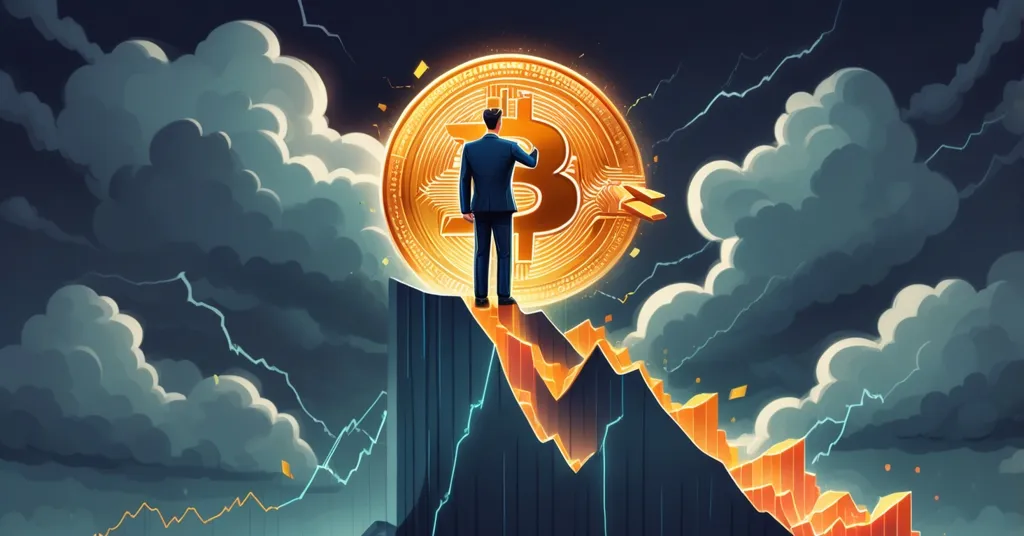Tim Draper Predicts Bitcoin at $250,000 by 2025 Despite $1B Crypto Market Crash

Tim Draper Stands Firm on Bitcoin at $250,000 by 2025 Amid $1B Market Crash
Billionaire venture capitalist Tim Draper is doubling down on his unwavering faith in Bitcoin, declaring it “valuable everywhere” even as the crypto market bleeds out with a staggering $1 billion in liquidations over the past 24 hours. Despite the chaos, Draper’s bullish outlook frames Bitcoin as a revolutionary force—a borderless, decentralized asset and a fierce hedge against government fiscal recklessness.
- Universal Worth: Draper champions Bitcoin’s decentralization, immutability, and liquidity as pillars of its global value.
- Market Mayhem: A brutal $1 billion liquidation wave underscores crypto volatility, yet Draper remains unshaken.
- Bold Forecasts: He predicts Bitcoin at $250,000 by 2025, with speculative peaks of $10 million or even “infinity” if hyperinflation guts the dollar.
Draper’s Bitcoin Gospel: A Vision of Financial Freedom
Let’s strip away the hype and dig into why Tim Draper, a heavyweight investor with a knack for spotting tech unicorns like Hotmail and Skype, is so fixated on Bitcoin. As an early adopter who famously predicted Bitcoin hitting $10,000 when skeptics scoffed at it as digital Monopoly money, his track record demands attention. His latest proclamation—Bitcoin is “valuable everywhere”—comes at a time when the market is anything but rosy. With Bitcoin dipping below $100,000 to $98,904 following geopolitical tremors like U.S. strikes on Iran’s nuclear sites, and Ether cratering 10% to $2,157, panic is palpable. Yet Draper stands firm, pointing to Bitcoin’s core strengths: a decentralized network free from government meddling, an immutable record of transactions, and high liquidity that, in theory, makes it easy to trade globally.
Bitcoin is “valuable everywhere.” – Tim Draper
Draper’s bigger picture is even more compelling. He sees Bitcoin as the ultimate “hedge” against government overspending—a shield for wealth when central banks print money like it’s confetti. With mounting global debt and inflation fears, his argument taps into a raw nerve. Economic heavyweights like Ray Dalio have warned of conditions potentially “worse than a recession,” while Mike Novogratz flags fiscal complacency as a looming disaster. Draper’s conviction isn’t just blind optimism; it’s a middle finger to a broken financial system, aligning with the ethos of decentralization and disruption we champion. But let’s not get swept away just yet—there’s plenty of turbulence to unpack before we crown Bitcoin king.
Bitcoin is the ultimate “hedge” against government spending. – Tim Draper
Bitcoin 101: Breaking It Down for Newcomers
For those just dipping their toes into crypto, let’s hit the basics. Bitcoin is a digital currency, created in 2009 by an anonymous figure (or group) known as Satoshi Nakamoto. Unlike traditional money, it’s not controlled by any bank or government. Instead, it runs on a decentralized network of computers worldwide, called nodes, that validate transactions on a public ledger known as the blockchain. Think of the blockchain as a digital notebook everyone can see and agree on, but no one can erase or rewrite—ensuring trust without intermediaries. Immutability means once a transaction is logged, it’s set in stone. Liquidity refers to how easily you can buy or sell Bitcoin without tanking the price, though recent volatility shows this isn’t always seamless. These traits, per Draper, make Bitcoin not just a gamble but a fundamental rethink of money itself.
Market Bloodbath: A Harsh Reality Check
Now, let’s pivot to the gritty reality of today’s crypto carnage. The market just took a $1 billion liquidation hit in a single day—a brutal reminder that this space is a rollercoaster. Bitcoin’s slide to $98,904, as reported by Bloomberg, ties directly to global risk aversion spurred by U.S.-Iran tensions. Ether, the second-largest crypto by market cap, fared even worse with a 10% nosedive. But it’s not just military headlines shaking things up. Central bank rate hikes, inflation spikes, and recurring crypto crackdowns in places like China all play a role in these gut punches. Bitcoin’s volatility, pegged at 52.2% by NYDIG (a leading crypto research firm), dwarfs traditional assets like gold at 15.5%. So, when Draper calls Bitcoin a “low-risk investment,” it’s hard not to raise an eyebrow. This isn’t a cozy savings account—it’s a high-stakes game where a single headline can wipe out billions overnight.
Tim Draper’s Bitcoin Price Prediction for 2025: Realistic or Overhyped?
Draper loves swinging for the fences with his price calls, and he’s not shy about it. He missed his 2022 prediction of Bitcoin reaching $250,000—a flub skeptics won’t let him forget. Back then, regulatory headwinds and a brutal bear market cycle squashed that dream. Undeterred, he’s pushed the timeline to 2025 for that same $250,000 target, insisting it’s still in play. Even wilder, he’s floated Bitcoin surging to $10 million or even “infinity” against the U.S. dollar if hyperinflation turns fiat into wallpaper. That’s the kind of sci-fi blockbuster talk you’d hear from fellow uber-bull Michael Saylor of MicroStrategy, who’s also built a career on sky-high Bitcoin bets. But let’s keep our feet on the ground. For $250,000 to happen by 2025, we’d need seismic shifts—mass retail and institutional adoption, a supply squeeze from the next halving (where Bitcoin’s issuance rate halves, boosting scarcity), or a full-blown dollar crisis. Without those catalysts, this feels more like wishful thinking than a safe bet. And don’t even get me started on “infinity”—that’s pie-in-the-sky nonsense unless the dollar literally turns to confetti.
Bitcoin could surge to “infinity” against the U.S. dollar. – Tim Draper
Bitcoin vs. Gold: A Fair Fight?
Draper doesn’t dodge the comparison to gold, a traditional store of value that’s outshone Bitcoin with a 25.3% annual return this year against Bitcoin’s more modest weekly upticks, per NYDIG data comparing Bitcoin and gold. His take? Bitcoin wins hands-down due to its borderless nature. You can’t smuggle a gold bar through customs without a headache, but Bitcoin is just a private key in your mind or a digital wallet on your phone—ready to cross any line without a passport. Structurally, Bitcoin’s edge is clear: a hard cap of 21 million coins (no more after the 33rd halving) versus gold’s 1.6% annual supply growth from mining. Plus, Bitcoin’s volatility, while high, is trending down over time—from triple digits a decade ago to 52.2% now—narrowing the gap with gold’s 3.6x lower risk profile.
Yet, gold isn’t rolling over. Central banks hoard it for a reason: it’s got societal trust baked in over centuries, doesn’t suffer from software bugs or exchange hacks, and remains a steadier bet during chaos. Bitcoin’s tech risks—think wallet vulnerabilities or network glitches—aren’t trivial, and its price swings can spook even die-hard fans (or “HODLers,” slang for long-term holders who cling to their coins no matter what). So, while Draper’s borderless argument holds water, gold’s stability keeps it in the ring, especially when markets turn ugly.
Altcoins in the Crossfire: Innovation or Instability?
While Draper’s laser-focused on Bitcoin, the broader crypto ecosystem is taking a beating too. Ether’s 10% drop to $2,157 shows altcoins—alternative cryptocurrencies—often fare worse in downturns. Unlike Bitcoin, which prioritizes being a store of value (akin to digital gold), platforms like Ethereum power decentralized finance (DeFi) and smart contracts—self-executing agreements coded on the blockchain that enable everything from lending to NFT marketplaces. These niches fill gaps Bitcoin doesn’t touch, driving innovation in ways that complement the king of crypto. But let’s not sugarcoat it: altcoins are often speculative wildcards with thinner liquidity and shakier fundamentals, making them prime targets for panic sells. While Bitcoin may reign supreme in Draper’s world, acknowledging altcoins’ role in pushing tech boundaries—and their higher crash risks—paints a fuller picture of this financial revolution.
The Dark Side of Draper’s Dream
Let’s not sip the Kool-Aid without a reality chaser. Draper’s unshakable zeal is hard to ignore, but Bitcoin isn’t a flawless savior. Beyond volatility, which can be explored further through various Bitcoin price volatility analyses for 2025, regulatory storm clouds loom large. The SEC’s ongoing crackdowns on crypto exchanges, potential global bans, and murky tax rules could throttle adoption faster than you can say “capital gains.” Then there’s the environmental angle—Bitcoin mining guzzles energy like a fleet of 747s, drawing ire from green advocates and policymakers alike. Technical risks persist too; a hacked wallet or protocol flaw can wipe out fortunes in seconds, a vulnerability gold doesn’t share. And let’s talk hype: Draper’s $10 million or “infinity” predictions are speculative at best, reckless at worst. We’ve got zero tolerance for scammers or baseless shilling here, so take note—billionaire or not, no one predicts markets with certainty. Do your own damn research before chasing these moonshot numbers.
The Road Ahead for Bitcoin
Draper’s rallying cry for Bitcoin resonates with those of us rooting for decentralization, privacy, and a tech-driven financial overhaul—what some call effective accelerationism, pushing for rapid progress despite the bumps. Bitcoin’s borderless nature isn’t just about dodging overreaching governments; it’s about accelerating a paradigm shift where money answers to code, not bureaucrats. Yet the path forward is a gauntlet. Near-term catalysts like the upcoming halving or institutional inflows from giants like BlackRock could fuel a rally. But hurdles—regulation, market sentiment, macro shocks—loom just as large. Bitcoin’s potential as digital gold hangs in the balance. Will Draper’s vision of a $250,000 future, often discussed in forums like Reddit threads on his predictions, prevail, or will today’s chaos prove too much?
Key Questions and Takeaways on Bitcoin’s Future
- What makes Bitcoin “valuable everywhere” according to Tim Draper?
Draper emphasizes Bitcoin’s decentralization, immutability, and liquidity, enabling it to operate as a global asset free from local political or economic constraints. - Is Bitcoin truly a low-risk investment as Draper claims?
Not by a long shot—volatility at 52.2% towers over gold’s 15.5%, and risks like hacks or glitches make it a high-stakes play despite long-term promise. - How realistic is Tim Draper’s Bitcoin price prediction for 2025?
His $250,000 target relies on mass adoption or economic crises, while $10 million or “infinity” feels like pure speculation given his mixed forecasting history. For more skepticism on this, check out discussions on Quora about the risks of such predictions. - Does Bitcoin outshine gold as a store of value?
Bitcoin’s borderless edge is real, but gold’s stability, societal trust, and immunity to tech risks keep it competitive, especially in turbulent markets. - How do altcoins fit into Draper’s Bitcoin-centric view?
While Draper focuses on Bitcoin, altcoins like Ethereum drive innovation in DeFi and smart contracts, though their higher volatility exposes them to steeper crashes. - Do geopolitical shocks undermine Bitcoin’s safe-haven status?
Recent drops tied to U.S.-Iran tensions and broader macro pressures show Bitcoin’s vulnerability to global uncertainty, challenging its reliability in crises. Insights into Draper’s take during market downturns can be found in this analysis of his views on crashes.



